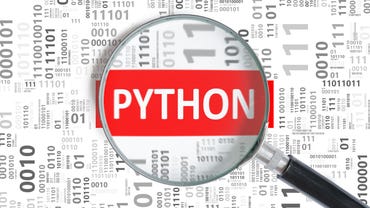
Programming language Python is undeniably a hot language to learn in 2021. It’s one of the top three languages in developer analyst RedMonk’s rankings, the Tiobe index, and the IEEE Spectrum ranking for electrical engineers. And that means it’s in high demand by employers in tech, finance, government, healthcare, science and other sectors.
Python was hatched by Dutch computer scientist Guido van Rossum back in 1991, and in the last few years, thanks to artificial intelligence and machine learning it shot to the top of the charts among programmers.
Go with Google for your Python education
Aspiring Python developers can’t go past Google’s Python courses, hosted online learning platform, Coursera.
Google curated a “crash course” for Python beginners, a second course on using Python for manipulating files and processes on an operating system, and a third one that speaks to one of Python’s core strengths: automating IT tasks by whipping up Python scripts.
Google’s Crash Course in Python is available for free as part of a 7-day trial, after which it costs $39 a month to continue. It’s actually part of the heftier Google IT Automation with Python course launched in January 2020. The beginner course requires no previous experience in programming.
It takes about 32 hours to complete over four weeks and covers syntax, automation with scripting, data types in Python, how to use variables, and programming loops to execute Python code infinitely.
Think of it as an on-ramp to Google’s IT automation with Python course.
The more serious Google IT Automation with Python Professional Certificate has overwhelmingly positive reviews with a user score of 4.8 out of 5 on Coursera.
This course really aims to get students familiar with core IT tools like the Git versioning system, the GitHub code-sharing site, and using Python to solve real business challenges, such as repetitive system administration tasks. It’s also a path to becoming skilled in cloud technologies.
This certificate takes 6 months to complete, and students can expect to be prepared for roles like advanced IT support specialist or a junior sys admin role.
It costs $39 per month to continue learning after the 7-day free trial ends, so customers are looking at a total bill of $234.
Pros:
- Google curates the course.
- It’s a certificate that large corporations recognize.
- Highly rated by past students.
Cons:
- The courses are aimed at beginners and new job entrants in the IT sector.
- No focus on data science or machine learning.
- Google wants you to use Google Cloud Platform.
ZDNet wanted to ensure that this set of recommendations didn’t just cater to beginners. We wanted some experts to tell us the best Python courses to take, even for those who are proficient in coding and familiar with the industry.
Anaconda makes a hugely popular distribution of Python combined with the statistical language R that’s focussed purely on the data science and machine learning crowd. There’s also integration between Microsoft’s VS Code and the Anaconda distribution of Python.
A number of popular deep learning courses teach Python coding skills, including Deep Learning Specialization, IBM’s Apple Data Science, and Stanford’s Machine Learning.
Sophia Yang, a senior data scientist at Anaconda, reckons Coursera’s deep learning courses with a focus on Python are the way to go.
“I enjoyed taking the deep learning courses on Coursera,” Yang told ZDNet. “The specializations are an excellent start for deep learning with Python. The lectures are clear, interesting, and engaging. They balance theory and practice well and provide enough intuition and knowledge for students to learn more independently. I also recommend checking out the official Python documents.”
Pros:
- Recommended by a data scientist from the maker of one of the top data science Python distributions.
- Coursera is widely recognized as a leader in mass online learning.
- Students gain a shareable certificate.
- The courses are relatively inexpensive. Stanford’s costs $79.
Cons:
- No obvious cons; however, these are multi-week courses that demand effort and energy.
Massachusetts Institute of Technology (MIT) is home to the MIT Computer Science & Artificial Intelligence Laboratory (CSAIL). It’s a premier US university, and CSAIL backs several groundbreaking AI research fields such as computer vision.
MIT offers its Python learning videos for free under MIT OpenCourseware, which include lectures, interactive assessments, assignments, and transcripts. It’s not a bad alternative for a university that can cost north of $40,000 a year to attend and lead to significant student debt.
“6.0001 Introduction to Computer Science and Programming in Python is intended for students with little or no programming experience,” says MIT OpenCourseware.
“It aims to provide students with an understanding of the role computation can play in solving problems and to help students, regardless of their major, feel justifiably confident of their ability to write small programs that allow them to accomplish useful goals. The class uses the Python 3.5 programming language.”
MIT OpenCourseWare is open for business and has proved to be popular. It has over 200,000 followers on Twitter, and the MIT 6.00 Introduction to Computer Science and Programming of Fall 2008 has received more than 4.9 million views, according to its 2020 annual report.
Pros:
- It’s a free course from one of the top US universities.
- Lectures and material are fresh, from 2016, and taught in Python 3.5.
- There’s a wealth of transcripts and video lectures.
Cons:
- The content can be a bit dry to listen to.
- It’s not going to be the same as actually attending lectures at MIT.
- There is no certification at the end of the course.
So, you might not be a beginner. You might even be working for the US Department of Energy and need to produce codes in Python.
David Beazley, a veteran Python coder, offers both paid-for courses and a slightly lighter version for free, aimed squarely at people involved in or keen on computer science.
Beazley’s courses are not for beginners or the faint-hearted. He describes his free course as “a no-nonsense treatment of Python that has been actively taught to more than 400 in-person groups since 2007.”
“Traders, systems admins, astronomers, tinkerers, and even a few hundred rocket scientists who used Python to help land a rover on Mars–they’ve all taken this course.”
The point is that his Python courses really treat computer science as the starting point rather than Python. He’s posted some details about his courses on GitHub.
Due to the pandemic, all of his courses are online-only, and they’re not cheap. If you want to learn how to write a compiler in Python, it’ll set you back $1,250 for a one-week online crash course.
“From 2007-2018, I was heavily involved with corporate training of Python and taught upwards of 400 courses on the topic — typically to scientists and software professionals,” Beazley told ZDNet.
“The “Practical Python” course is a lightly edited version of the training materials that I developed and taught in these courses.”
He decided to release the course materials under the Creative Commons (CC) license in 2019 because he saw a lot of Python training material was either behind paywalls or on sites littered with advertisements and SEO.
“Not only that, I felt that a lot of it was presenting Python in an overly complicated, often muddled manner. Honestly, I was kind of annoyed, so I thought it might be useful to provide a battle-tested course in a spam-free format that anyone could access. Also, I figured that the CC license would encourage more creative use of the material. For example, foreign translations, or use by teachers in developing their own courses.”
He doesn’t want his courses at https://www.dabeaz.com/courses.html to be described as Python courses because they’re really about computer science.
“Although they often use Python, they are focused on core topics in computer science as one might encounter in the first year of a CS Masters or PhD program. Typical attendees are working professionals who would like to tackle advanced material without the hassle of enrolling in a graduate program,” he told ZDNet.
“These courses are quite challenging. For example, I offer a course titled “Advanced Programming with Python.” The ordering of the words in that title is important because the emphasis is on “Advanced Programming.” That’s something that’s quite different and substantially more challenging than simply learning a few “advanced” Python tricks.”
Pros:
- The Creative Commons licensed content is free.
- Industry leaders in data science…




